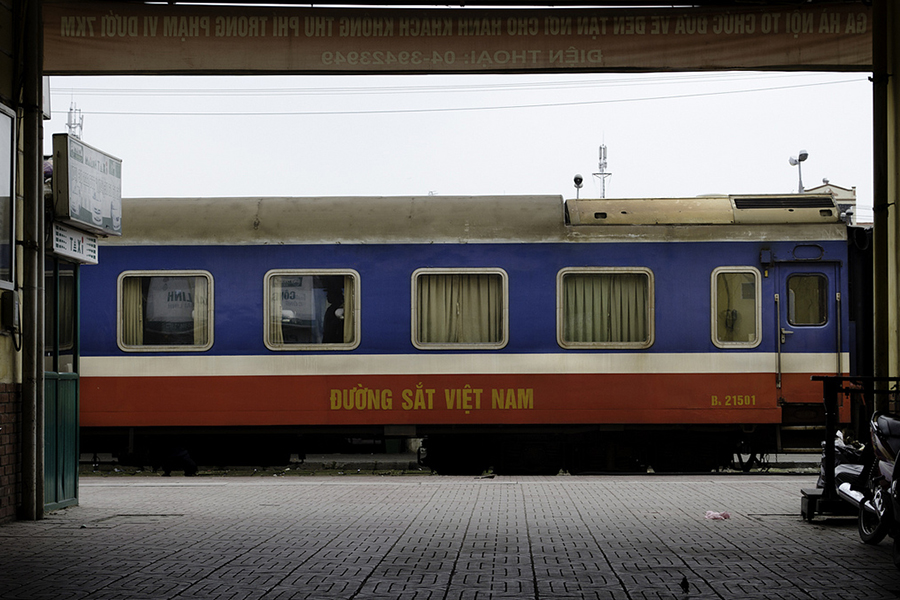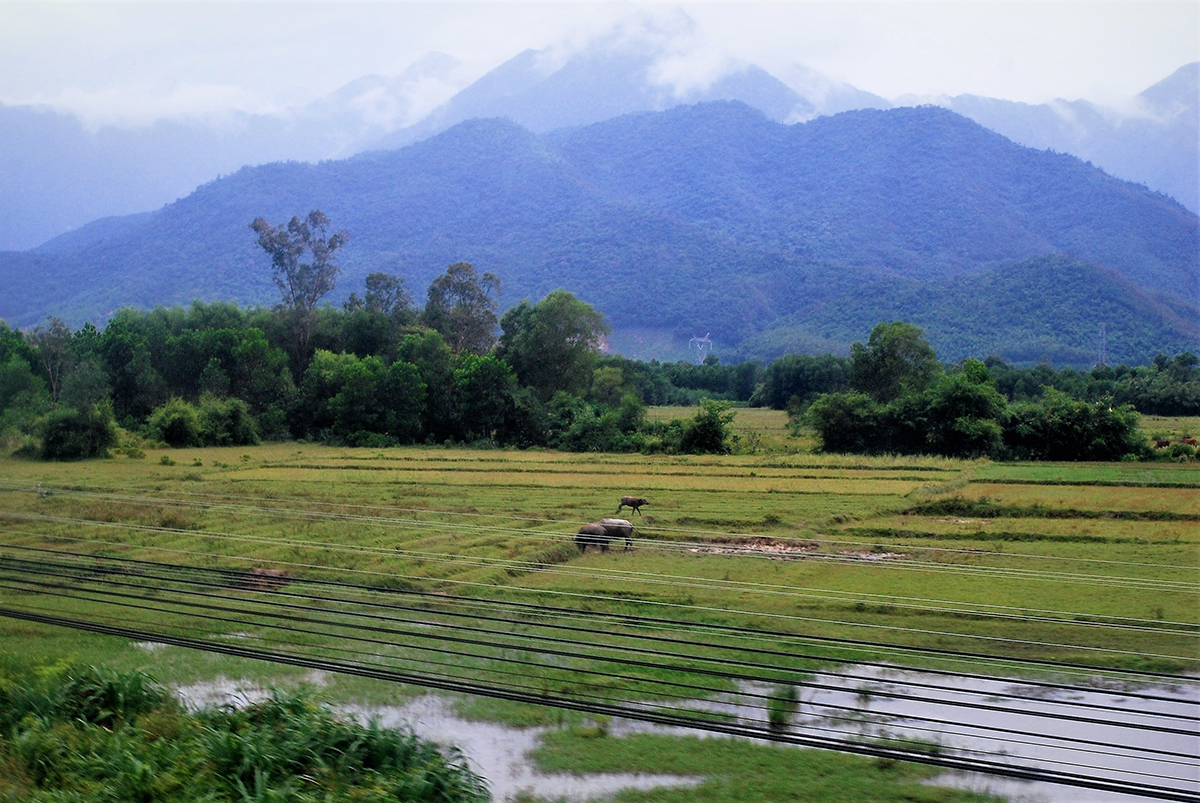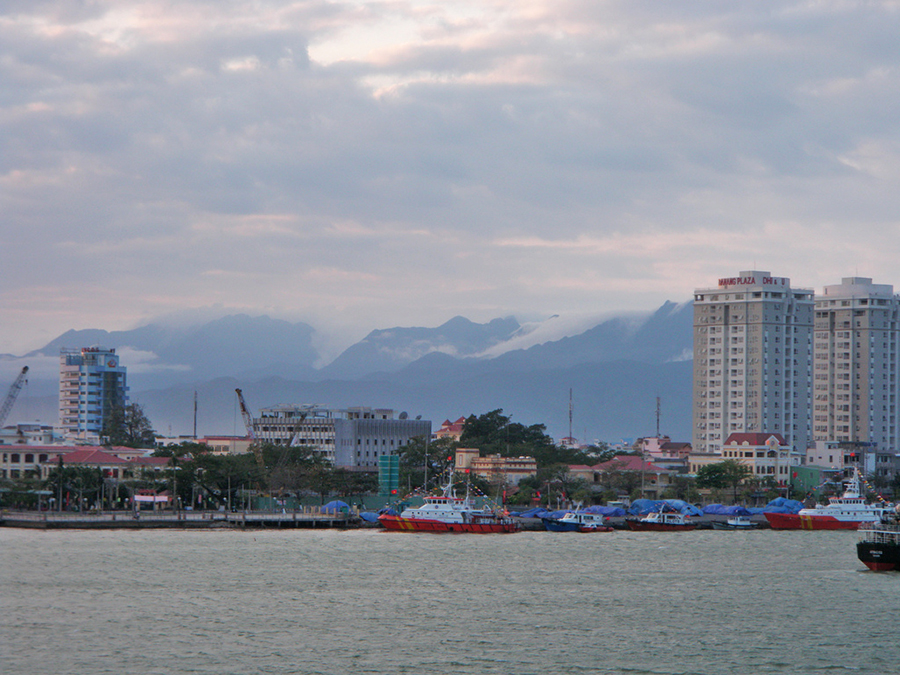Spanning the entire length of the country, from the cloud covered mountains of the North to the branching river deltas in the South, the Reunification Express is a great steel spine connecting all the major towns and cities. Join Benjamin Brown as he journeys from the nation’s capital, Hanoi, to the coastal city of Da Nang.

Hanoi Central Station (Photo: alexFranka via Flickr)
It’s 7 pm. Half an hour until the train departs. Looking around I notice how sparse my surroundings are; aside from several uniform rows of seats and the ticket office, the space is devoid of visual clutter. Tucked neatly away to one side, however, is a modestly sized supermarket, and with time to relinquish I amble over. Casually perusing the shelves, I am reminded of the advice given to me about stocking up on supplies as the onboard food trolleys carry risks of sickness and salmonella.
Cradling the booty, an assortment of sweet treats including Kẹo mè xửng, ultra-chewy sesame peanut candy, I return to the bustle of boarding and discover that the train has already pulled into the station. Further words of wisdom pop into my cranium: ‘aim to arrive at the station in good time as sleeper trains have been known to leave early’. That in mind, I stride through the mass throng to the platform, deftly side-stepping a screaming infant curled up in a heap on the polished marble floor.
Air where there should be steps, with considerable effort I haul myself up onto the train. I barely have time to gather my belongings and what’s left of my dignity when a piercing bell sounds, indicating to passengers that the train is ready to depart.
Leaving Hanoi
With the wheels well and truly set in motion, the train begins slaloming its way between shantytown dwellings and concrete apartment blocks, slowly building up speed as the city gives way to green rural pastures. Completed in 1936, the 1,726km-long Hanoi–Saigon railway, or ‘Transindochinois’, first ran in what was then French Indochina, and after two decades of separation between North and South, in 1976 the Reunification Express united the nation’s railways once more. Back then, Hanoi to Saigon took a mammoth 40 hours and 20 minutes. Luckily for me however, journeying to Da Nang on the SE3 clocks in at a breezy 16 hours and 38 minutes.

Boarding a sleeper train (Photo: Los viajes del Cangrejo via Flickr)
Shuffling down a narrow corridor past winding conga lines of largely Vietnamese passengers, I manage, finally, to locate my cabin. Pulling the sliding door across, I feel a pang of relief upon seeing that the cabin is empty. Setting my belongings to one side I begin taking in the room. Shoehorned opposite one another are two bunk-beds, and on the far side by the window there sits a small table and lamp. Looking closer, I also notice narrow shelves built into the walls above each bed as well as a night light and individual power sockets. It can hardly be considered luxury living, but it will do.
Unpacking my essentials, I’m reminded once more of advice about how, as a precautionary measure, one should ideally tether all valuables to something at night. With that in mind, I choose to sleep on the lower berth, with my belongings safely tied to the bedpost. That, and the fact that reaching the upper berth requires superior upper body strength, given that there’s one solitary rung from which to haul your entire body weight in lieu of a ladder. Satisfied with my work I lie back, soaking up the pleasant quietude of my new surroundings. Eyes closed, I’m on the brink of going under when I hear a rat-at-at-at on the cabin door.
Cabin Camaraderie
“Hello, can I come in?”, queries the phantom voice from the other side of the partition. Reluctantly I muster up a half-strangled “Of course, sure”. Forcefully heaving the sliding door aside, almost breaking it in the process, a paunch, middle-aged gentleman of modest stature presents himself to me in the doorway. “Chào, my name is Rico, is nice to meet you”. “Hi, my name is Ben, where are you headed may I ask?”. “You mean where am I going?”, Rico replies in what sounds like a Latin American accent, but for all I know could be Swahili. “Yes”, I respond curtly. “I’m going to Huế”, he replies. Floundering, I say “but isn’t that north of Da Nang?” “Is north, yes, but I get off early”, Rico somewhat bemusedly explains. “Oh I see, my mistake, I thought the train went directly to Da Nang without stopping”.
The conversation has started off as jolted as the train itself. Establishing a mutually agreeable silence I leave Rico to his own devices, that is to say, to sort and sift through his curiously extensive array of electronic gadgetry. After some time, Rico suddenly and unaccountably broke our unspoken vow to be unspoken by speaking. “You know in Brazil, where I come from, I am a Michelin starred chef”, he asserts. “Is why I want to go to Huế you know, cause’ some of the best food in the whole country comes from here, like their steamed rice cakes called Banh Beo”, Rico adds excitedly. “They also do a great…”

Mountain views (Photo: Benjamin Brown)
Lights Out
Rico was now in full flow and recounting his past adventures. Intriguingly, though also enviably, I learn he has been travelling now for a year, putting his work on hold to fulfil a lifelong dream of exploring Asia, one sleeper train at a time. “Rico, I’m quite tired now so I think I’ll get ready for bed, mind if I turn out the light?”, I say wearily. “No man, I got to be up early anyway if I want to make my stop – by the way, did you know that Huế is also known for the dish…” “Night Rico”.
With Rico sleeping soundly, I tiptoe my way out into the gangway. Blinkered, I stumble my way over to the nearest bathroom, yanking open the door. Clearly, it had been a mistake not to give them a cautionary once-over upon arrival. Having been given stern advice on the necessity of bringing your own toilet roll, by pampered Western standards at least the facilities are extremely basic and I decide I’m not really in need of the bathroom after all.
After washing my face in one of the carriage’s plain beige basins I shamble my way back to the cabin. By now night has well and truly descended, and looking out the carriage window the train may as well be hurtling down an endless tunnel such is the matte thickness of the all-enveloping black. Careful not to wake the chef from his peaceful slumber, I tread softly to my bed, and despite the somewhat coarse blankets the train’s gentle rocking motion sends me to sleep almost instantly.
That is until I am awoken by the sounds of raised voices coming from beyond the cabin’s flimsy partition. A heated argument has broken out among two of the passengers. Following the shouting, I hear what sounds like a muffled cry, and then, almost as soon as the commotion had abated all is silent. Disconcertingly, the situation recalls Murder On the Orient Express. I suppose that if someone has been murdered, I shall have to prepare myself for a visit first thing next morning from an immaculately tailored, moustachioed Belgian gentleman. With that absurd image hovering in my mind, I fall into a deep, sustained torpor.

Hai Van Pass (Photo: Gavin White via Flickr)
The Coast is Always Changing
When I awake, bright sunshine is pouring in through the cabin’s small, rounded window. Looking across at the opposite bunk, I see an empty bed where my travel compadre once was. In my weariness I had dozed through the scheduled stop off at Huế and missed my opportunity to bid the charismatic chef farewell. Taking my mind off that fact, I turn to observe through the condensation-streaked glass the sweeping verdant landscape beyond. Dotted at intervals among the endless rice paddies are lone water buffalo and the ramshackle huts of the occasional farm or village. Alongside the train I spot two young Vietnamese children, a boy and a girl, cycling down an adjacent dirt track and waving with their free hand to nameless faces staring back at them.
With a dramatic backdrop of mountain vistas, the train soon slowly curves its way towards the coast, where I am afforded views of empty beaches and dense, emerald green vegetation. Up ahead, the train laboriously ascends the steep inclines of the Annamese mountains. Following a route known as the Hải Vân (Ocean Cloud) Pass, on account of the region’s floating sea mists, I become transfixed by the sight of the train arcing around on itself as though it were chasing its own tail.

Da Nang from across the bay (Photo: International Disaster Volunteers via Flickr)
Feeling dehydrated, I wander between carriages in search of refreshments. Slightly dazed, I inadvertently find myself crossing over into the ‘Soft Seat’ section of the train, where people occupy a single narrow seat for the entire 16-hour-long journey. Looking around at the hive of activity I see that all human life is here, from the wizened old granny to the troublesome young child. Being wheeled around on trolleys are great sheaves of corn cobs along with chicken feet, a popular delicacy across South-East Asia. Made up largely of Vietnamese families I immediately feel out of place, and so I quietly close the door behind me and return to the relative comfort of the cabin.
I have only walked a few paces, however, when I see the glinting high-rise apartment blocks of Da Nang up ahead. Now on its final descent, the train begins picking up speed, as though it were as eager as its passengers to arrive at our destination. Gathering up my belongings, trusty loo roll included, I ready myself to disembark as the train sputters its way slowly toward the station.
Journeying on the Reunification Express Sleeper train connected me with cultures different from my own, sharing a cabin and meaningful conversation with someone who would have otherwise have remained a stranger. For those visiting Vietnam, hopping on an overnight train should be high on the agenda. The uniqueness of the experience alone is worth more than the throwaway convenience of a 90-minute internal flight or the endurance test of an interminable bus journey. It may be a well-worn cliché, but taking a ‘sleeper’ truly is all about the journey and not the destination.